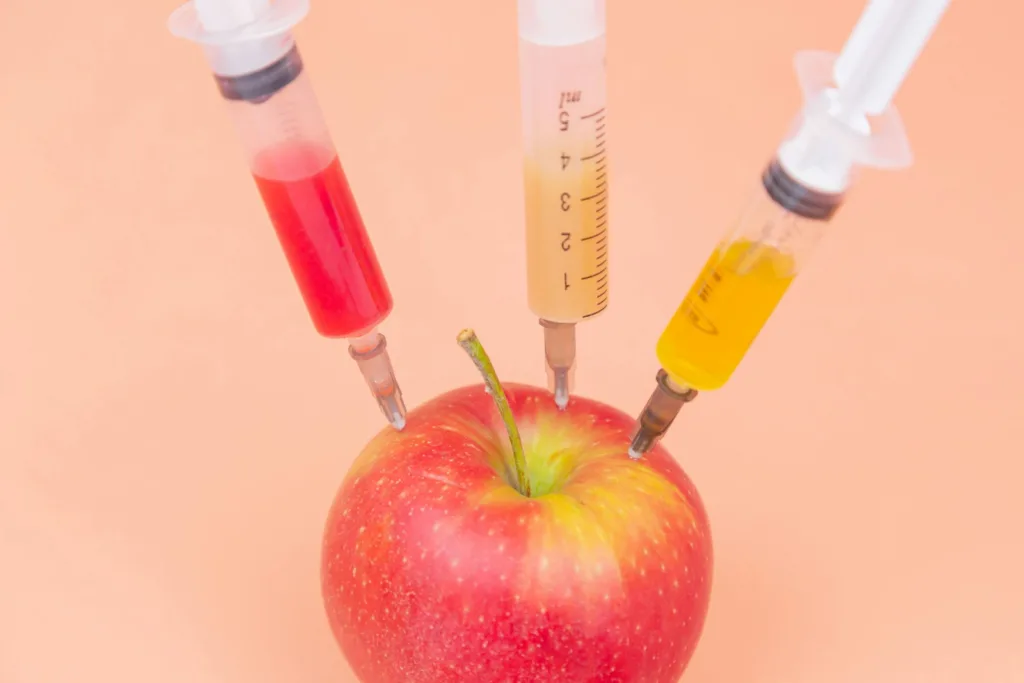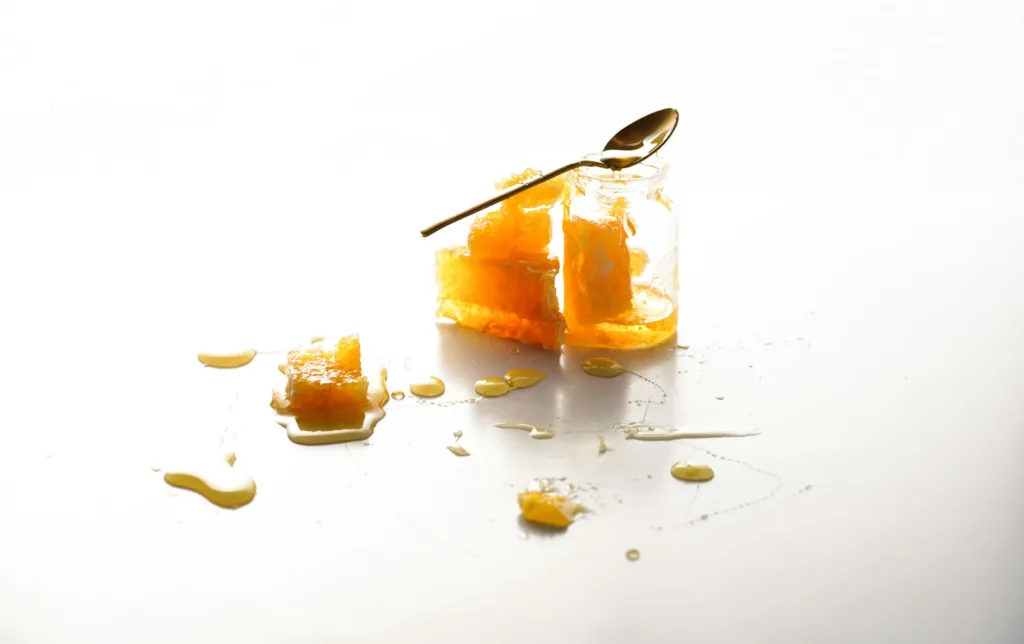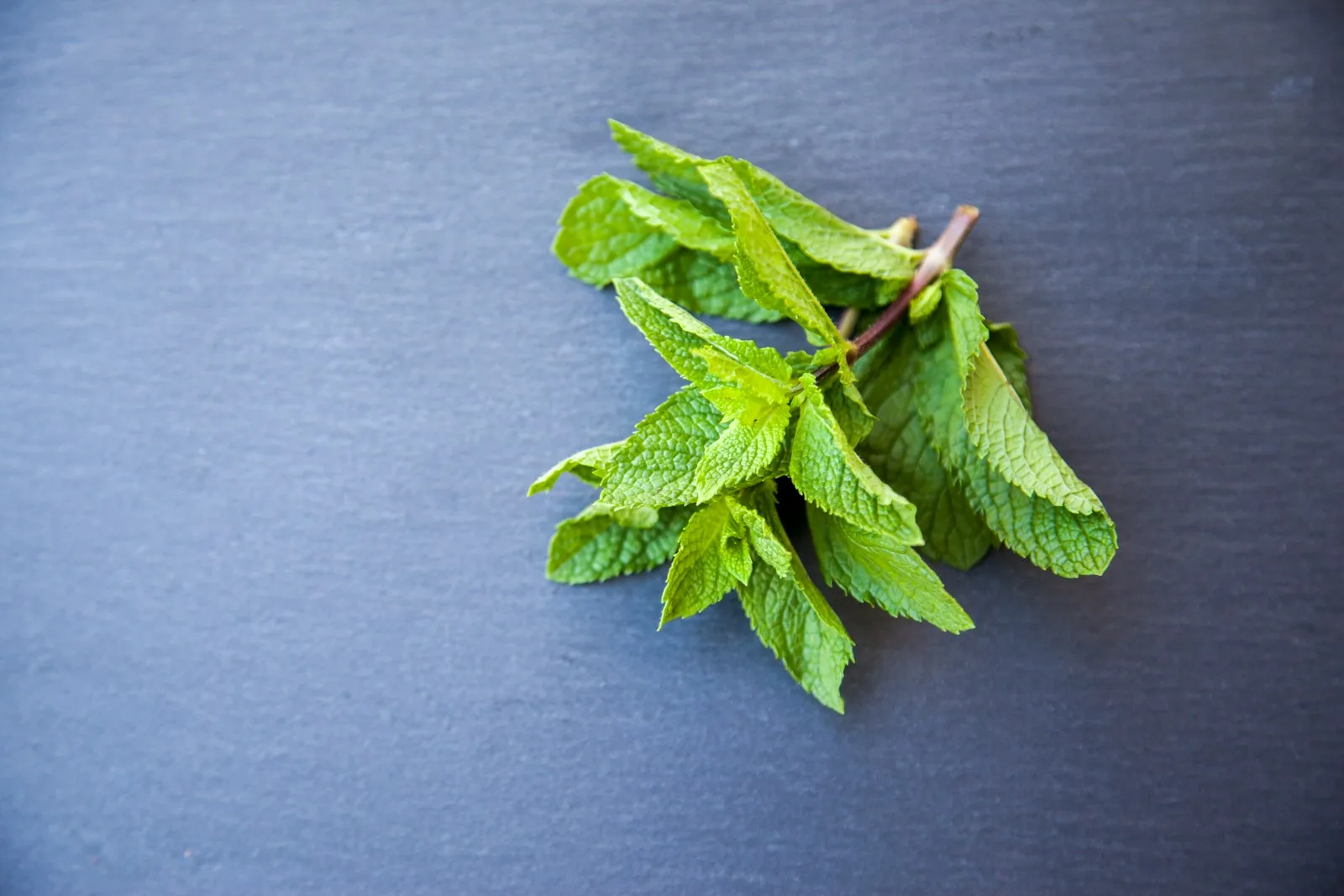BHT in foods, short for butylated hydroxytoluene, is a synthetic antioxidant. Imagine a freshly cut apple; after a while, it starts to turn brown. That’s because oxygen exposure breaks down the apple’s cells. Antioxidants, like BHT, act like tiny shields, slowing down this oxidation process. In the food industry, BHT is used to extend the shelf life of products, particularly those containing fats and oils, which are more prone to spoilage.

Table of Contents
BHT in foods: Where Do You Find Them?
BHT plays peek-a-boo in a surprising number of processed foods. Here’s a quick rundown of their favorite hangouts:
- Cereal: Those colourful breakfast loops might have a longer shelf life thanks to a sprinkle of BHT.
- Chewing Gum: Keeping that gum chewy and flavorful can involve a dash of BHT.
- Baked Goods: From cookies to crackers, BHT in foods can help prevent those baked goodies from going stale.
- Potato Chips: The irresistible crunch of chips might be preserved with a touch of BHT.
- Instant Noodles: The convenience of instant noodles often comes with a side of BHT.
Is BHT Safe to Eat? The Not-So-Simple Answer
This is where things get a little murky. The U.S. Food and Drug Administration (FDA) has generally recognized BHT as safe (GRAS) for human consumption in limited quantities. However, some research suggests a potential link between BHT and certain health concerns, including:
- Cancer: Some animal studies have shown an increased risk of cancer with high BHT intake.
- Hormonal Disruption: BHT in foods might mimic certain hormones in the body, potentially leading to imbalances.
It’s important to note that most of these studies involve very high doses of BHT, far exceeding the amounts typically found in food. However, the lingering questions around potential health effects are enough to give some consumers pause.
The BHA, BHT, and TBHQ Connection: A Trio of Shelf-Life Extenders
BHT isn’t the only player in the world of food additives used to extend shelf life. There are two other closely related characters you might encounter on food labels: BHA (butylated hydroxyanisole) and TBHQ (tert-butylhydroquinone). Let’s delve into their similarities and subtle differences.
Chemical Cousins with a Common Goal
All three—BHA, BHT, and TBHQ—belong to a class of food additives called synthetic antioxidants. Imagine a freshly cut apple; after a while, it starts to turn brown. That’s because oxygen exposure breaks down the apple’s cells. Antioxidants, like these three, act like tiny shields, slowing down this oxidation process.
In the food industry, BHA, BHT, and TBHQ are used to prevent spoilage in a variety of products, particularly those containing fats and oils, which are more prone to going rancid.
BHA: The Shelf-Life Superhero (But Maybe Not Your Everyday Hero)
- Function: Similar to BHT in foods, BHA acts as an antioxidant to extend shelf life and prevent spoilage in fats and oils.
- Where you’ll find it: BHA can be found in various processed foods, including potato chips, cereals, chewing gum, and some meat products.
- Safety Concerns: Like BHT, some studies suggest potential links between BHA and certain health concerns, including cancer and hormonal disruption. However, more research is needed, and the FDA considers BHA safe for human consumption at approved levels.
A Tricky Trio: Similarities and Subtle Differences
Here’s a quick comparison to highlight the key similarities and differences between these three antioxidant buddies:
| Feature | BHT | BHA | TBHQ |
|---|---|---|---|
| Chemical Structure | Similar to BHT | Similar to BHT | Similar to BHT |
| Function | Antioxidant | Antioxidant | Antioxidant, Flavor Stabilizer |
| Commonly Found In | Cereals, Chips, and Goods | Chips, Chewing Gum, and Meat Products | Vegetable Oils, Instant Noodles |
| Safety Concerns | Potential Links to Cancer & Hormonal Disruption | Potential Links to Cancer & Hormonal Disruption | Potential Links to Cancer & Hormonal Disruption |
| Regulatory Status | GRAS (Generally Recognized as Safe) by FDA at approved levels | GRAS by FDA at approved levels | GRAS by FDA at approved levels |
BHA, BHT, and TBHQ all serve a similar purpose in the food industry: extending shelf life. While generally recognized as safe by regulatory bodies at approved levels, some studies suggest potential health concerns.
Should You Ditch BHT in foods Altogether? Making Informed Choices
The world of food additives can be a confusing one, and BHT is no exception. So, the big question remains: should you eliminate BHT from your diet? The answer, like most things in life, isn’t a simple yes or no. Here’s a breakdown to help you make informed choices:
The Regulatory Perspective: Weighing the Evidence
The U.S. Food and Drug Administration (FDA) has generally recognized BHT as safe (GRAS) for human consumption in limited quantities. This means that extensive research has been conducted, and at the approved levels typically found in food, BHT is not considered a significant health risk.

However, some studies, particularly those involving high doses of BHT, suggest potential links to:
- Cancer: While the evidence isn’t conclusive, some animal studies have shown an increased risk of cancer with very high BHT intake.
- Hormonal Disruption: BHT’s chemical structure might mimic certain hormones in the body, potentially leading to imbalances. More research is needed to fully understand this potential effect.
The Individual Approach: Considering Your Health and Preferences
Even if regulatory bodies deem BHT safe at typical consumption levels, you might still have concerns. Here are some factors to consider when making your personal decision:
- Overall Diet: A balanced diet rich in whole foods naturally minimizes your BHT exposure. If you primarily consume processed foods, reducing BHT intake might be more important.
- Health Conditions: If you have underlying health concerns or specific dietary restrictions, consulting a doctor or registered dietitian is crucial. They can provide personalized advice based on your unique needs.
- Precautionary Principle: Some individuals prefer a more cautious approach and might choose to avoid BHT altogether, regardless of the current scientific consensus.
Finding Your Balance: A Spectrum of Choices
There’s no single “right” answer when it comes to BHT. Here’s a spectrum of approaches you can consider:
- Minimize BHT Intake: Become a label-reading detective and prioritize BHT-free options whenever possible. Focus on fresh, whole foods and cook more meals at home.
- Occasional Indulgence: If you enjoy a BHT-containing snack every now and then, don’t stress! Remember, context matters. A balanced diet is key.
- Complete Avoidance: For those with specific health concerns or strong preferences, eliminating BHT altogether might be the best approach.
Making the Switch: BHT-Free Alternatives
Convinced that a BHT-free diet is the way to go, or simply curious about exploring more natural options? Here’s a detailed guide packed with delicious and healthy BHT-free alternatives to transform your pantry and fridge. Remember, going BHT-free doesn’t have to mean sacrificing flavor or convenience.
Fresh is Best: Nature’s Bounty of Shelf-Stable Options
- Fruits and Vegetables: They’re the rockstars of any healthy diet, and luckily, they come pre-packaged with natural antioxidants. Stock up on in-season produce for a vibrant and BHT-free feast. Apples, oranges, pears, and grapefruits are all fantastic choices with excellent shelf life. For something a little different, explore dried fruits like cranberries, raisins, and apricots. Just be mindful of added sugars in some commercially dried fruits; opting for unsweetened varieties is the best bet.
Pantry Staples: Power Up with Natural Preservatives

- Whole Grains: Brown rice, quinoa, oats, and whole-wheat pasta are fantastic BHT-free pantry staples. They’re packed with fiber and complex carbohydrates and naturally boast a longer shelf life compared to refined grains.
- Nuts and Seeds: These nutrient powerhouses are a fantastic source of healthy fats, protein, and fiber. Almonds, walnuts, cashews, pumpkin seeds, and sunflower seeds are all excellent choices. Keep them in airtight containers to maintain freshness.
- Legumes: Beans, lentils, and chickpeas are another BHT-free pantry hero. They’re incredibly versatile and can be soaked and cooked for fresh consumption or canned for a convenient shelf-stable option.
Spice Up Your Life: Natural Antioxidants to the Rescue
Don’t underestimate the power of spices! Many herbs and spices boast natural antioxidant properties that can help extend the shelf life of homemade dishes. Rosemary, thyme, oregano, and cloves are all fantastic BHT-free alternatives. Get creative and explore different spice blends to add flavor and natural preservation to your cooking.
Preserving at Home: Traditional Techniques for a BHT-Free Twist
For those who enjoy the satisfaction of home preservation, several traditional methods don’t involve BHT. Here are a few to consider:
- Canning: This time-tested technique utilizes heat and airtight sealing to preserve fruits, vegetables, and even meats.
- Dehydrating is a fantastic way to extend the shelf life of fruits, vegetables, and herbs. Dehydrated foods are lightweight, portable, and retain a significant amount of their nutrients.
- Fermentation: This ancient technique preserves food while creating beneficial probiotics. Kimchi, sauerkraut, and yogurt are all examples of fermented foods.
Beyond the Kitchen: BHT-Free Snacking on the Go
Busy lifestyles don’t have to mean reaching for BHT-laden processed snacks. Here are some BHT-free options to keep you fueled on the go:
- Homemade Trail Mix: Combine your favorite nuts, seeds, and dried fruits for a customizable and energizing snack.
- Hard-boiled eggs are a protein-packed and portable snack that’s naturally BHT-free.
- Fresh or Frozen Fruits: Pack a container of berries, grapes, or sliced melon for a refreshing and BHT-free on-the-go treat.
- Homemade Granola Bars: Ditch the store-bought varieties and whip up a batch of BHT-free granola bars with your favorite nuts, seeds, and dried fruits.
Embrace the Farmer’s Market: A Treasure Trove of Fresh, Local, and BHT-Free Goodness
Supporting local farmers and enjoying the bounty of the season is a fantastic way to find fresh, BHT-free produce. Farmer’s markets often offer a wider variety of fruits and vegetables than your typical grocery store, allowing you to explore unique and seasonal options. Many farmers also prioritize sustainable and natural growing practices, which is a bonus!
Think Outside the Box (or Bag): Alternative Packaging for BHT-Free Options
While some BHT-free options might come in packaging, consider these alternatives for a more sustainable approach:
- Bulk bins: Many stores offer nuts, seeds, grains, and dried fruits in bulk bins, allowing you to purchase only what you need and minimize packaging waste. Bring your own reusable containers to truly ditch the packaging altogether.
- Reusable produce bags: Opt for reusable produce bags instead of plastic bags at the grocery store. It’s a small change that can make a big difference.
The Final Bite: Knowledge is Power When it Comes to BHT
BHT is a common food additive that extends shelf life. While generally considered safe by regulatory bodies, some research suggests potential health concerns. By understanding BHT’s uses and exploring alternatives, you can make informed choices about the food you consume. Remember, a balanced diet is key! Don’t stress about the occasional BHT-containing.
Beyond the Label: Frequently Asked Questions About BHT in foods
Understanding BHT can be a confusing journey. To clear up any lingering questions, let’s dive into an FAQ format:
Is BHT the same as TBHQ?
BHT and TBHQ are close cousins! They both belong to the same family of antioxidants used as food preservatives. They share some similarities in their chemical structure and function, but there might be slight variations in how they’re metabolized by the body.
Are there any natural alternatives to BHT?
Absolutely! Nature provides a bounty of antioxidant powerhouses. Some food manufacturers use natural alternatives like vitamin E, rosemary extract, and citric acid to extend shelf life.
What if I see BHT on an organic label?
Great question! BHT is not allowed in certified organic foods, according to USDA regulations. Organic products must rely on natural preservation methods.
I’m worried about BHT in foods. Should I avoid all processed foods?
Not necessarily. Remember, the FDA has deemed BHT safe at typical consumption levels. However, if you’re concerned, focus on minimizing processed foods and opting for fresh, whole ingredients whenever possible.
What are some healthy, shelf-stable snacks without BHT?
There are tons of delicious options! Here are a few ideas:
Dried fruits and nuts: Nature’s perfect snack pack, packed with nutrients and natural antioxidants.
Homemade granola bars: Control the ingredients and skip the preservatives with this DIY option.
Roasted chickpeas are a crunchy, protein-rich snack that stores well.
Freeze-dried fruits and vegetables: a lightweight, shelf-stable option bursting with vitamins.
Is BHT used in cosmetics or other products?
Yes, BHT can be found in some cosmetics, particularly in products containing fats or oils that are prone to spoilage. It can also be used in some industrial applications, like rubber products.
I’m seeing conflicting information about BHT online. What should I trust?
Be cautious of sensationalized headlines. Reliable sources come from reputable scientific organizations, government websites (like the FDA), and established health institutions.
Should I talk to my doctor about BHT?
If you have underlying health concerns or specific dietary restrictions, consulting a doctor or registered dietitian is always a good idea. They can provide personalized advice based on your individual needs.
Is BHT bad for the environment?
There’s limited research on the environmental impact of BHT specifically. However, like many food additives, it’s always wise to consider the environmental footprint of processed foods in general.
The world of food additives seems overwhelming. Any tips?
Don’t get discouraged! Knowledge is power. Here are some closing thoughts:
Focus on a balanced diet. Prioritize fresh, whole foods whenever possible.
Become a label-reading detective. Pay attention to ingredients and be mindful of BHA, BHT, and TBHQ.
Don’t be afraid to ask questions. Consult reliable sources or healthcare professionals for personalized advice.
By understanding BHT and navigating the world of food additives with a critical eye, you can make informed choices about what you put on your plate. Remember, a healthy diet is all about balance and variety. So, enjoy exploring the delicious world of food while keeping an eye on those sometimes-cryptic ingredients!
Demystifying BHT: A Food Preservative Under the Microscope
Have you ever scanned the ingredient list on your cereal box and stumbled upon the cryptic “BHT”? Fear not, curious consumer! This article is your one-stop shop for understanding BHT in food, from its purpose to potential concerns.
BHT 101:
- BHT Explained: BHT stands for Butylated Hydroxytoluene. Imagine it as a tiny bodyguard for fats and oils in food. BHT, an antioxidant, helps prevent them from spoiling and turning rancid – like a bodyguard keeping troublemakers (oxygen) at bay.
- BHT’s Best Friend: BHT often works alongside its partner-in-crime, BHA (Butylated Hydroxyanisole). Think of them as a superhero duo, double-teaming to extend a food’s shelf life.
- BHT’s Hideouts: BHT is most common in processed foods like cereals, chips, chewing gum, and instant noodles. You might also find it lurking in some dried fruits and nuts.
- Nature vs. Science: Unlike natural antioxidants in fruits and vegetables, BHT is synthetically manufactured.
- The BHT Debate: The safety of BHT is a bit of a hot topic. Some studies suggest potential health concerns, while others haven’t found a clear link.
- BHT & Cancer: Headlines might scream “BHT causes cancer!” However, the research is ongoing. Regulatory agencies generally consider BHT safe at typical food levels.
- BHT for the Birds (and Us): While generally safe for humans, BHT can be harmful to some animals, like birds. So, keep those feeders BHT-free for your feathered friends!
- BHT Bellyache: If you have a sensitive stomach, BHT might cause some indigestion. If you notice this after eating BHT-containing foods, consider limiting them.
- BHT Beyond the Plate: BHT isn’t just a food thing. You might also find it in cosmetics, rubber products, and even jet fuel!
- BHT vs. Your Health: The amount of BHT matters. Regulatory agencies set safe limits for food, and these levels are generally considered okay for human consumption.
Making Informed Choices:
- BHT Blacklist: Want to avoid BHT? Check the ingredient label! Look for “BHT” or “Butylated Hydroxytoluene” and choose BHT-free products if you prefer.
- BHT-Free Breakfast: Many cereal brands are ditching BHT. Look for cereals that advertise “BHT-Free” or “Made with Natural Antioxidants.”
- Fresh is Best: Whenever possible, choose fresh fruits, vegetables, and whole foods. They’re naturally packed with antioxidants and don’t need BHT to stay fresh.
- DIY Dips: Skip the store-bought dips loaded with preservatives. Whip up your own healthy hummus or guacamole for a fresh and BHT-free alternative.
- Organic Option (Sometimes): Organic food doesn’t guarantee BHT-free, but it’s a good starting point. Organic standards generally restrict the use of synthetic preservatives.
BHT Beyond the Hype:
- Context is Key: Just like with salt or sugar, the amount of BHT is crucial. Safe limits are established for food, so occasional consumption of BHT-containing foods is unlikely to cause harm.
- Science in Progress: Research on BHT’s long-term effects is ongoing. If concerned, talk to your doctor, but for most people, moderate BHT intake is likely okay.
- Beyond BHT: BHT is just one of many food additives. There are many other preservatives and antioxidants used, each with its own safety profile.
- Focus on the Big Picture: A healthy diet is about more than just avoiding a single ingredient. Prioritize a balanced diet rich in fruits, vegetables, and whole grains.
- Knowledge is Power: Understanding ingredients like BHT empowers you to make informed food choices.
Striking a Balance:
- Moderation is Key: Even if you’re not actively avoiding BHT, there’s no need to live off processed foods. Opt for fresh options whenever possible.
- Label Decoder Ring: Don’t be intimidated by ingredient lists! Use them to your advantage. Research unfamiliar ingredients online or consult a registered dietitian.
- Fearmongering vs. Facts: Some online sources might exaggerate the dangers of BHT. Stick to reliable sources like government health agencies or reputable medical websites for accurate information.
- The BHT Benefit: While some may demonize BHT, it does play a role in extending the shelf life of certain foods, which can help reduce food waste. This is especially important in areas with limited access to fresh produce.
- Freshness First: Just because a food contains BHT doesn’t automatically make it healthy. Prioritize fresh, whole foods and limit processed options, BHT or not.
Making Your Own Choices:
- Listen to Your Body: You are the best judge of how your body reacts to food. If you experience discomfort after consuming BHT-containing foods, cut back or avoid them altogether.
- Variety is Key: Don’t get stuck in a processed food rut! Explore a wide variety of fresh and minimally processed foods to ensure a good mix of nutrients in your diet.
- The Future of Food: As consumer preferences shift, the food industry is constantly evolving. Look for brands that are ditching artificial additives and opting for more natural alternatives.
- Be a BHT Buddy (Sort Of): If you’re concerned about BHT, spread awareness! Talk to friends and family about what you’ve learned, but remember, knowledge is power, not panic.
- Enjoy Food! Don’t let BHT turn mealtime into a science experiment. Focus on the joy of food, cook more at home using fresh ingredients, and savor delicious, nutritious meals.
Bonus Fact: BHT has some industrial applications beyond food! It’s used in things like rubber products and even jet fuel to prevent spoilage and degradation.






